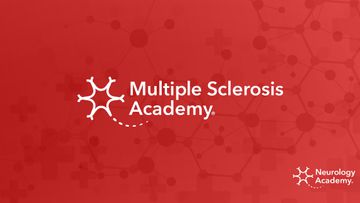What's new in relapsing MS? Expert Perspectives on Pathogenesis, Targeting B Cells for Treatment, and Advances in Disease State Monitoring
Event reportsChaired by Xavier Montalban, Multiple Sclerosis Centre of Catalonia (CEMCAT), with presentations from Amit Bar-Or, University of Pennsylvania, Ludwig Kappos, University Hospital Basel
Xavier Montalban introduced the session and set the scene for assessing and staging people's MS, by looking at the classification of MS phenotypes into relapsing and progressive, active and non-active. He noted that this year, the terms have been adapted to include progressive disease as referring to accrual of disease progression independent of relapse activity.
Ludwig Kappos discussed features to consider in addition to a thorough clinical assessment.
- He noted that MRI imaging has always had an important role in diagnosis, but advocated for its use in assessment, both in terms of staging and of disease progression.
- baseline tissue damage and subsequent repair
- lesion burden
- assessment of prognosis / long term disability risk
- He also noted the expanded McDonald criteria (2017) including both symptomatic and asymptomatic, and oligoclonal bands in the cerebrospinal fluid (CSF) to aid diagnosis.
Xavier then added other activity indicators such as neurofilament light polypeptide (NFL) levels in the blood, and tissue atrophy. He also shared a recent position paper on monitoring treatment response with a focus on NEDA (no evidence of disease activity). He also suggested judging minimal disease activity by T2 lesions as a way of defining therapeutic targets.
Key references:
Gasperini C, Prosperini L, Tintoré M, Sormani MP, Filippi M, Rio J, Palace J, Rocca MA, Ciccarelli O, Barkhof F, et al, and the MAGNIMS Study Group. 'Unraveling treatment response in multiple sclerosis: A clinical and MRI challenge', Neurology. 2019 Jan 22;92(4):180-192.pubmed
Prosperini L, Mancinelli C, Haggiag S, et al, 'Minimal evidence of disease activity (MEDA) in relapsing-remitting multiple sclerosis', Journal of Neurology, Neurosurgery & Psychiatry 2020; 91:271-277.
Ludwig issued a cautionary note that assessing brain atrophy should be done at no more frequently than every 12 months, and that standardised assessments are still limited and require further validation. Nevertheless, he advocated that newer ways to use imaging to monitor MS include:
- Using global brain volume to predict disease activity
- Quantitative measures around grey matter volume
Key references:
Cortese R, 'A study of MRI cortical lesions in myelin oligodendrocyte glycoprotein antibody associated disease', ECTRIMS Online Library. 09/12/19; 279524; 246
Sorensen PS, Sellebjerg F, Hartung HP, Montalban X, Comi G, Tintoré M,' The apparently milder course of multiple sclerosis: changes in the diagnostic criteria, therapy and natural history', Brain, awaa145, https://doi.org/10.1093/brain/awaa145
Makshakov G, Magonov E, Totolyan N, Nazarov V, Lapin S, Mazing A, Verbitskaya E, Trofimova T, Krasnov V, Shumilina M, et al, 'Leptomeningeal Contrast Enhancement Is Associated with Disability Progression and Grey Matter Atrophy in Multiple Sclerosis', Neurology Research International, vol. 2017, Article ID 8652463, 7 pages, 2017. https://doi.org/10.1155/2017/8652463
Further reading included papers on thalamic and brain mass atrophy, and on the peripheral rim (Absinta et al).
Xavier provided a case study of a 33 year old male smoker and ex-alcoholic, gastric bypass for morbid obesity, and demonstrated his MRI scan, and the three men discussed differential diagnoses. (They returned to this same case study later on, in light of evidence they shared regarding new understanding of the MS immunopathogenesis.)
MS immunopathogenesis
Amit shared a thorough explanation of MS immunopathogenesis as we now understand it, noting that historically, we have thought that MS was directed by a single cell, the T cell. He explained that we now know it is affected by interactions between various different immune cells, including B cells, T cells and microglia.
Key reference:
Li R, Patterson KR, Bar-Or A. Reassessing B cell contributions in multiple sclerosis. Nat Immunol. 2018;19(7):696-707. doi:10.1038/s41590-018-0135-x
Xavier then discussed the growing evidence supporting multiple roles for B cells in MS pathophysiology:
- Autoantibody production - B-cell clones produce antibodies in the cerebrospinal fluid (CSF) and the central nervous system (CNS)
- T-cell activation - B-cells are highly efficient at presenting antigen to and activating T-cells
- Cytokine production - B-cells from patients have abnormal proinflammatory profiles
- Formation of ectopic follicle-like structures - ectopic B-cell follicles are found in the meninges of patients with MS
Key references:
Colombo M, Dono M, Gazzola P, Roncella S, Valetto A, Chiorazzi N, Mancardi GL and Ferrarini M, 'Accumulation of Clonally Related B Lymphocytes in the Cerebrospinal Fluid of Multiple Sclerosis Patients', J Immunol March 1, 2000, 164 (5) 2782-2789; DOI: doi.org/10.4049/jimmunol.164.5.2782
Constant SL, 'B Lymphocytes as Antigen-Presenting Cells for CD4+ T Cell Priming In Vivo', J Immunol May 15, 1999, 162 (10) 5695-5703;
Bar‐Or A, Fawaz L, Fan B, Darlington PJ, Rieger A, Ghorayeb C, Calabresi PA, Waubant E, 'Abnormal B‐cell cytokine responses a trigger of T‐cell–mediated disease in MS?', Annals of Neurology, First published: 26 April 2010 doi.org/10.1002/ana.21939
Lisak RP, Ragheb S. The role of B cell-activating factor in autoimmune myasthenia gravis. Ann N Y Acad Sci. 2012;1274:60-67. doi:10.1111/j.1749-6632.2012.06842.x
Xavier discussed the latest findings in studies OPERA 1 and OPERA 2, examining the use of ocrelizumab in RRMS after 5 years. Results have found a reduction in gadolinium enhancing lesions and T1 and T2 lesions. He also mentioned the phase 3 ASCLEPIOS study on ofatumumab which found clear reduction in relapse rate and an impressive effect on gadolinium enhancing lesions.
(A more in-depth evaluation of all three of these studies was given by MS Academy faculty members Dr David Paling and Prof Gavin Giovannoni as they discussed new findings in disease-modifying therapies following the European Association of Neurology's 2020 Virtual Conference.)
BTK inhibitors
Xavier discussed the rationale for BTK inhibitors (BTKi) in MS treatment. BTKi works by inhibiting Bruton’s tyrosine kinase (BTK), a protein that is important for the activity of inflammatory cells like B-cells and microglia. These cells drive the inflammation that causes nervous system damage in MS. Inhibiting BTK aims to lessen this inflammation.
Xavier gave an overview of a recent trial of Evobrutinib (Montalban; 2019) where patients with relapsing MS who received 75 mg of evobrutinib once daily had significantly fewer enhancing lesions during weeks 12 through 24 than those who received a placebo. Phase 3 of the trial is now underway.
Another BTKi called SAR442168 is in trial phases at present, and is designed to cross the blood brain barrier. Phase 2 found that it was effective against gadolinium enhancing lesions at week 12 after treatment.
Xavier suggested that clinical candidates for BTKi treatments might include:
- active naive patients
- those switching from first line for inefficacy or intolerance
- those switching from second line for safety issues
- after anti-CD 20 treatment in stable patients
Key references
Montalban X, Arnold DL, Weber MS, Staikov I, Piasecka-Stryczynska K, Willmer J, Martin EC, Dangond F, Syed S,, 'Placebo-Controlled Trial of an Oral BTK Inhibitor in Multiple Sclerosis' June 20, 2019, N Engl J Med 2019; 380:2406-2417, DOI: 10.1056/NEJMoa1901981
BTKi SAR442168 clinical trial
Take home messages
Xavier asked that we remember that ultimately, MS is still a clinical diagnosis, even in the face of all these new tools and imaging techniques.
Ludwig noted that the emerging evidence suggests that staging is important in managing MS and that looking both clinically and across imaging and biological markers is important.
Amit summed both views up well by highlighting that we are facing a growing toolkit to support each patient as an individual. He suggested that the new challenge is to select the best options from within that toolkit that will advocate for each patient and what is best for them, and to find the best treatment that will result in their own NEDA.
Related articles
Encouraging excellence, developing leaders, inspiring change
MS Academy was established five years ago and in that time has accomplished a huge amount. The six different levels of specialist MS training are dedicated to case-based learning and practical application of cutting edge research. Home to national programme Raising the Bar and the fantastic workstream content it is producing, this is an exciting Academy to belong to.

